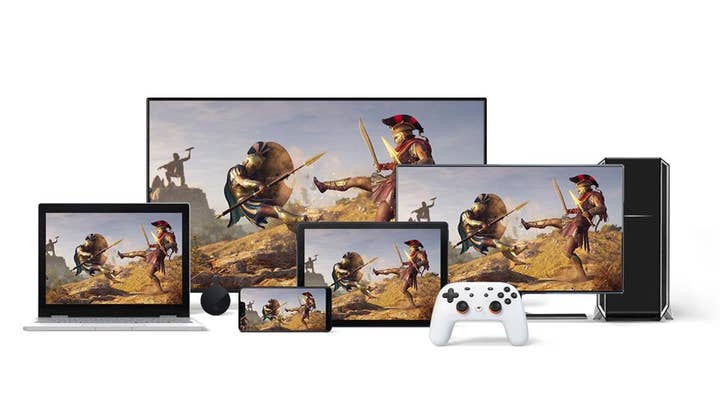Google is making a "spectrum of bets" on Stadia content
As Google unveils new Montreal development studio, Stadia Games & Entertainment boss Jade Raymond discusses the platform strategy
Some of the biggest questions about Stadia since the game streaming service was announced have been about how Google would handle its first foray into internal game development. With the service set to launch November 19, it's time for some of those questions to get answers.
To that end, Google's VP and head of Stadia Games & Entertainment Jade Raymond speaks with GamesIndustry.biz about the company's strategy for the service.
"The role I'm filling as head of SG&E is building out all of the exclusive content for Stadia," Raymond says. "We have a plan that includes building out a few different first-party studios, and also building up the publishing org to ship exclusive content created by indie devs and other external partners."
The first of those studios is in Montreal, the company announced today. It's a familiar setting for Raymond, who not only grew up in the city but had stints with Ubisoft and Electronic Arts in Montreal. Even so, the goal in front of Raymond is different as the creations of third-party publishers like Ubisoft and EA serve slightly different purposes than those of a platform holder.
"It's very important for first-party games... to be games that wouldn't be possible on any other platform"
"It's very important for first-party games, in my opinion, to be games that wouldn't be possible on any other platform," Raymond says. "I think that's what's really exciting and why we're building out the first-party teams."
For Google Stadia, Raymond says she sees two primary paths to creating games impossible on other platforms. The first one is at the heart of the Stadia sales pitch; with all of the number-crunching being done in the cloud, Google's games can be designed around the limits of its own hardware rather than those of the users' devices.
"There are a lot of things that being cloud native enables that you're just not going to be able to see on other platforms, and I think that's the job of first-party, to really show that off and let people imagine what those things are."
Whether it's creating more detailed simulations, more advanced AI behaviors, or MMO-like experiences that redefine "massively multiplayer," Raymond wants to see what developers can create once they have modern hardware constraints significantly lifted.
"A fully physics-simulated game is one of the Holy Grails of game creation since Trespasser was being imagined 20-something years ago, and now we finally have a platform where we'll be able to deliver some of those experiences," she says, name-checking Dreamworks Interactive's ambitious yet ultimately unsuccessful 1998 Jurassic Park tie-in.

"In terms of multiplayer, everyone is essentially playing in one big LAN party as far as the tech is concerned," she adds. "There is no difference or constraints from an architecture perspective of how far the users are, or worrying about replication and all the other things that typically limit the number of people you can have in a game."
The second big opportunity Raymond sees for Google's own Stadia games is the ability to incorporate the company's non-gaming technology. She specifically pointed to Google's AI tech as an opportunity, noting a Duplex demo the company gave where an AI assistant called up a stylist to book a woman's haircut in a (mostly) natural-sounding conversation.
"It won't be four years before gamers get to see the new exclusive, exciting content. There will be some coming out every year, and more and more each year"
"Imagine having that kind of AI powering NPCs in story-based games," Raymond says. "Instead of having the usual quest-giver that repeats a static line of dialogue, imagine having Google Duplex-powered believable human interactions embedded in any game that has narrative."
Raymond was also excited about the kinds of content that could become possible through the integration of Stadia tech with Google's other offerings like YouTube. As an example, she suggested a novel treatment for a documentary about the history of video games.
"At the segment where they show you Atari, all of a sudden instead of just watching it, you could actually be playing it because the button inputs on the controller you're holding can suddenly control that video stream for the portion you tag as interactive," Raymond says.
We ask about the timing of Google just now ramping up its game development efforts with the Montreal studio. Given the nature of AAA dev cycles, couldn't Stadia's fate as a success or failure already be determined by the time the key titles are finally ready to launch?
"It is a long term view that Google is taking," Raymond stresses. "For a big bet and a huge new IP that's going to fully leverage the cloud, it may be several years. But we do have quite a few exclusive games in the works that will demonstrate some of the exciting things about the platform all along the path. It won't be four years before gamers get to see the new exclusive, exciting content. There will be some coming out every year, and more and more each year."
As she explains, Google has "a spectrum of bets" it's working on, each with a different time frame. At first, Raymond concedes Stadia's lineup will be mostly third-party games, perhaps a few with some slight changes from other versions or Stadia-exclusive features. After that will come the second-party games from independent developers.
"Initially we're going to have some interesting indie-style titles we sign and they might look a little different, or take advantage of a YouTube integration, or have a different role for a streamer," Raymond says. "But they won't right away solve every problem or uncover every possibility of what cloud-native gaming is going to open up."
"It's this new space to figure out all of a sudden. What's going to be fun? Where's the value really going to lie?"
And even if the Stadia technology works perfectly, the teams that make use of Stadia's new features will necessarily run into design challenges.
"That's one of the things that's exciting to me and exciting to a lot of the people we're recruiting," Raymond says. "It's this new space to figure out all of a sudden. What's going to be fun? Where's the value really going to lie?"
For instance, Stadia tech might enable developers to put gamers in the middle of a historic battle with thousands of soldiers, but those developers will have to figure out what setup actually makes that experience fun for players.
Raymond wonders, "Is that going to be cool, or just too chaotic? Is the experience cool but we want most of it to be AI and it's just you and five people, so maybe the interesting part is the Stadia backend can render all that AI to give you the feeling of it but not the actual agency and chaos of 1,000 real people playing? Those are the kind of things we're going to have to figure out... That's the excitement of being at the ground floor on a new platform that's going to change a lot."
Another difference in Raymond's role as a first-party is that she's now responsible for supporting third-party developers as partners. With Stadia just getting off the ground, she sees this as an opportunity to rethink every part of the platform-partner model to get the best results possible. For now at least, she says the goal is to offer second-party partners the same services and support the internal studios receive, whether that be insights and research or technical experts to assist them in making the most of Stadia's features.
Given Stadia's ability to stream the same game to TVs, PCs, or smartphone screens, we ask about the development focus for the first-party portfolio. Will Stadia Games & Entertainment make games intended to thrive equally on all formats, or would it be open to creating games that might lend themselves clearly to one format or another?
Raymond responds by thinking back to her time at Ubisoft Toronto working on Splinter Cell: Blacklist, when the developers wanted to let PC players and console users play the Spies vs. Mercs multiplayer mode against one another.
"The common opinion at that time was that no one would want to play against a PC player because there's such an advantage, that it would never work," Raymond says. "And obviously at that point, the platforms weren't really keen on that. Then Fortnite proved that wrong. Even further, no one would have dared to consider playing the same shooter on mobile. It was already beyond imagination that a console player would play against a PC player, never mind a mobile player.
"The thing Fortnite did was prove that the most important thing for people is spending time with their friends in a way that's convenient and fits their lifestyle and mood in that moment, in my opinion. I think we want a different approach to thinking about games. Rather than thinking about the hardware, [we're] thinking more about what mood people are in and what their available time is."










